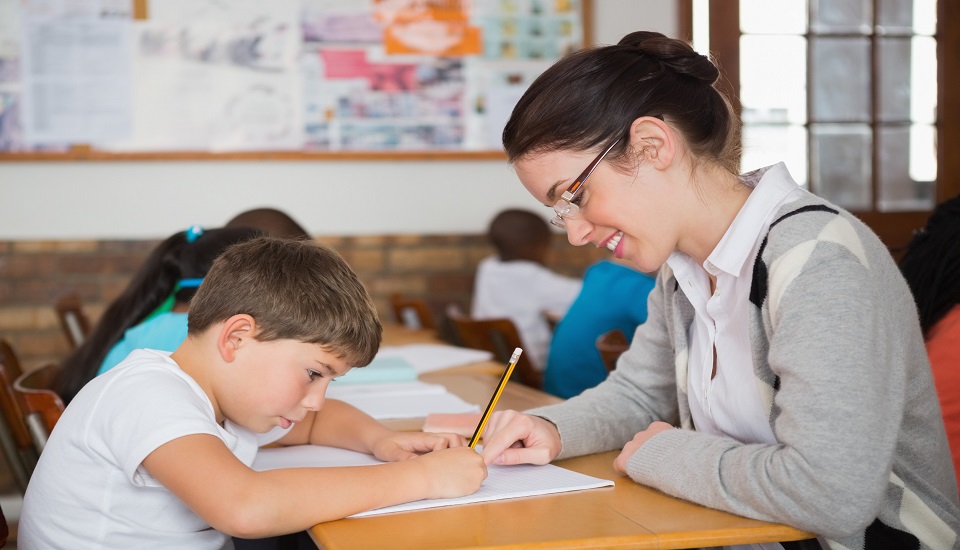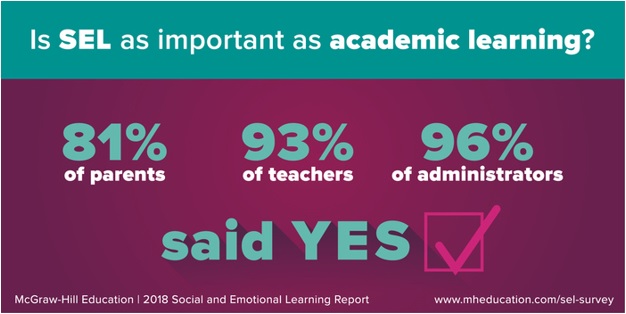Seamless Ways To Incorporate Social-Emotional Learning In The Classroom: A Comprehensive Guide
28th November 2023

In today’s generation, there is competition everywhere and in every field. The pressure to perform well both academically and in extra-curricular activities is taking a toll on every student's emotional well-being. All this pressure on every student leads to misbehaviour in the classroom, which makes the teaching job more difficult for every teacher.
However, there’s a way to help students improve their mental and emotional well-being with the help of the SEL (Social-Emotional Learning) method. By implementing the SEL method, you can improve classroom behaviour and at the same time, it decreases misbehaviour and aggression of students as well.
According to prnewswire.com , 93% of teachers also agree that SEL is important for academic learning.

Source: prnewswire.com
One thing is clear and established SEL can be beneficial in lots of ways for student's mental and emotional well-being and to create a harmonious environment as well. In this blog post, we will be exploring various effective strategies to implement social-emotional learning methods to create a positive and supportive classroom environment for every student.
Before moving to the topic, can we ask you a question? Do you follow us on Social Media? We regularly share upgraded educational content, tips, feedback, and more. Check us out by clicking the profiles here - Facebook / Twitter / LinkedIn / Pinterest / Instagram / YouTube
So, without any further delay, let’s get started.
What is Social-Emotional Learning (SEL)?
SEL (Social-Emotional Learning) basically is the process through which any individual can acquire the necessary knowledge and skills which can help them to find and develop a healthy identity, emotional regulations, inter-personal skills, and empathy.
By implementing SEL into the classroom every teacher can empower their students to thrive academically, socially, and emotionally. Now, let’s explore some of the effective strategies to incorporate SEL practices in your classroom.
Effective Strategies to Incorporate SEL (Social-Emotional Learning) In Your Classroom:
1. Start the Day with a Student Check-in
One of the effective ways to implement the SEL method in your classroom is by check-in on every student at the beginning of the day. This activity will encourage students to express their emotions which can help them to set their day ahead positively. Below we have shared various approaches to check-in you can implement:
Stoplight Colors or Emoji Chart: You can use a stoplight system where students can use either red, yellow, or green lights to show how they are feeling. Green signifies they are feeling good, Yellow indicates less than ideal or good emotional state and Red signifies they are in a bad mood and they need a break. Alternatively, they can also use an emoji chart where students can use different emojis to represent their current moods.
Feelings journal: You can encourage your students to maintain a journal where they can write and express their emotions every morning and at the end of the day. This activity will help students to reflect on their emotions and to become more aware about their emotional state.
Group Discussion: You can conduct time-to-time group discussions within a group of students where every student can share their feelings one by one. This will help them to learn quality life skills like- active listening, empathy, and support for their peers.
2. Foster Partner and Group Work
The collaborative learning experience not only improves academic growth but also provides room for the development of social–emotional skills. Students can practice communication, cooperation, and teamwork through partner and group work. Below we have shared some techniques that can be employed in class to encourage partner and group work.
Strategic Pairings: Categorize students into pairs according to their strengths and abilities. For instance, a more outgoing student can be paired with a shy one to foster mutual support and enable students to learn from each other.
Project-Based Learning: Assign group projects requiring learners to work together towards a common objective. Not only will this build teamwork but also enhance problem-solving and decision-making abilities.
Accountability Structures: Within groups, accountability structures should be put in place such as specific roles or rotating leadership responsibilities. This will motivate the learners to take charge of their learning process as well as enhance interpersonal skills.
3. Cultivate a Culture of Kindness
Nowadays, students living in a competitive academic environment, it becomes more important for teachers to show support to their students by acknowledging their efforts and celebrating it as well. You must foster or cultivate a culture of kindness within the classroom which will promote respect, empathy, and most importantly inclusivity for every student in the classroom. Here are some effective easy to incorporate kindness:
Gratitude Exercise: You can do this activity by encouraging your student to express gratitude towards their classmates by giving appreciative comments or by writing a thank-you note. This will also help to create a positive classroom environment which also helps students to form strong bonds with their peers.
Random Act of Kindness: You can create certain situations deliberately which encourage students to do random acts of kindness towards each other. They can do simple activities like- offering a helping hand, complimenting other work, or showing empathy towards their peers who are going through tough situations.
4. Expand Social-Emotional Vocabulary
One of the effective ways to teach students about the Society-Emotional learning method is by teaching social-emotional vocabulary. It will help students to accurately understand and express their emotions. The more students expand their emotional vocabulary the more they can understand or communicate clearly about their feelings. Below we have shared some of the effective ways to enhance the social-emotional vocabulary of students:
Word Exploration: You can consider new emotional vocabulary words to students and discuss their meaning with students. You can encourage students to use these words on a daily basis wherever possible and in written work.
Contextual Learning: While you’re teaching emotional vocabulary, you can connect it with real-life situations or stories. It will help them to understand the different emotions which will ultimately foster empathy and understanding the perspective of others.
Emotional Charades: Thai is one of a fun activity where you can encourage students to act out different emotions and other classmates have to figure out the right emotions which is being portrayed, Additionally, it also promotes emotional recognition and genuine understanding of other situations.
5. Allow Time for Meaningful Conversations
As we live in a fast-paced world, it is essential for every teacher to create a classroom environment where students can have meaningful conversations with teachers. You can make time to listen to your student actively and empathetically to improve the student’s social-emotional development. Below we have shared various was to have meaningful conversations:
One-on-One Check-Ins: This involves having individual sessions with students in order to talk about their overall well-being, difficulties, and personal goals. Such interaction will make you connected to all the learners.
Classroom Conversations: If you ask each student to sit in a circle, maybe in groups of six, and have open-ended discussions with them as they express their opinions or experiences.
Peer-to-Peer Interaction: You can also encourage students to talk with other students. In doing so, it allows them to learn empathy, understand each other better, and communicate more effectively.
6. Teaching Mindfulness Practices
Mindfulness practices are invaluable resources that enable students to develop self-awareness, focus, and emotional regulation. This enables the student to be present and manage their emotions effectively. Below we have shared how you can introduce mindfulness in your classroom:
Breathing exercises: Teach students different breathing techniques like deep belly breathing or counting breaths to help them relax and refocus.
Mindful observation: Show students how they can employ their senses to engage mindfully with the environment around them. It helps them to increase their awareness of the present moment and appreciation and enhance gratitude.
Guided meditations: You can introduce short guided meditations or mindfulness apps into the classroom routine. Such activities can be done at the start or end of a day so as to bring calmness and mental clarity.
Incorporate Social-Emotional Learning (SEL) To Improve Overall Well-Being Of Students
Nowadays, students have so much pressure to do well in every field from academics to extra-curricular activities, which is both mentally and emotionally draining. One of the best ways to provide support is with the help of the SEL (Social-Emotional Learning) method. Teachers who have pursued courses like Counselling Courses for Teachers know the importance of incorporating of SEL method in the classroom.
However, in this blog post also, we have shared various easy-to-implement SEL strategies that can help you foster a positive and supportive learning environment where students develop vital social and emotional skills that can contribute to students' overall well-being, growth, and success.
So start prioritizing social-emotional learning in our classrooms and empower our students to thrive academically, emotionally, and socially.
We believe education should be accessible for everyone. That’s why we don’t charge for our blogs. Find the right course that will help you in your career with us, contact us at - + 1800–212–6400. You can mail us at act@asiancollegeofteachers.com.
Written By : Abhishek











